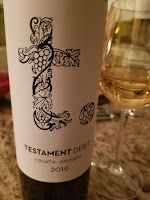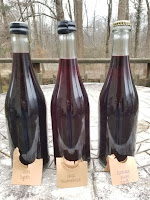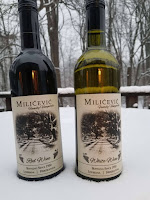Last week I was introduced to the
Salute! distillery through a tasting kit purchased by a friend. The kit included 14 unique liqueurs created from botanicals and fruit grown on the owner's (Renato Vicario and Janette Wesley) South Carolina farm or Italian estate. Renato Vicario is the author of
Italian Liqueurs The History and Art of a Creation, and uses his knowledge of historical recipes in crafting the Vicario brand liqueurs. Some of the herbs grown in South Carolina and used in the various liqueurs are French Tarragon, Cardoons, Artichokes, Lavender and Lemon Verbena, Rosemary, Dittany of Crete, Wall Germander, and Aloe Vera. The tasting kit also included a detailed brochure describe the ingredients and history behind each recipe. Here are the liqueurs, abbreviated tasting notes, and the distillery notes. Cheers.
Monks Secret Liqueur: an Amaro with the aroma of xmas spices, chalky texture, warm baking spices, herbs, & mint
"The Cistercians, Benedictines, and Trappists were part of a network of religious houses which exchanged ideas and procedures but also kept a few secrets. After careful reading of ancient monastic texts, we crafted this maceration of over 15 aromatic herbs and spices and named it after these famous monastic orders. "
Quintessence Liqueur: an aroma of baking spices, firm body, almost root and dirt like with hints of licorice
"The word Quintessence became synonymous with elixirs, medicinal alchemy, and the philosopher’s stone itself. Conjured by herbs and spices from around the world, Quintessence’s deeply complex characteristics invoke divine satisfaction. Drink it neat after dinner, or hot drink with a piece of lemon peel. It refreshes in summer when added to a sparkling mineral water over ice. "
Seville Orange Liqueur: candied orange aroma, velvety oranges, zesty, no bitterness or sourness
"The spiny evergreen is native to Vietnam, but is now grown throughout the Mediterranean region and the world. Perhaps the most pleasing way to use it is in a cocktail, splashed into Gin and Tonic, or transform a Mojito by replacing the lime with Seville Orange liqueur."
Olive Leaf Liqueur: heavy indeterminate aroma, olive notes, and lifting citrus and spices
"Created with only the fresh tender emerging leaves from ancient olives, estate grown at our family farm at Villa Sant’Andrea, Cortona, Italy, and finished with lemon in South Carolina, this fresh and delicate amaro is versatile and delightful. "
Artichoke Liqueur: artichoke and lemons, slightly chalky and herbal finish
"Prepared for the acute enthusiast Vicario Black Labeled Liqueurs indicate the most indispensable ingredients, above all, the ingredient of time to age to perfection. Artichoke leaves bring a floral, and grassy flavor that dissipates into a persuasive bitterness in this deeply delightful liqueur. "Dragoncello Liqueur: anise aroma, licorice, depth
"The herb, known to many as French Tarragon, has been cultivated from Ancient Greeks to Thomas Jefferson as it was known for its healing properties for the stomach and liver. Improved immensely by ageing, this exotic liqueur redolent of spices, faint traces of anise and licorice, scented and aromatic, never coy but enticing, is well served after a meal or alongside biscotti or ice creams, and can be used in fine patisserie baking."
Amore Mio Aperitivo Liqueur: mint, some grapefruit, herbal finish
"Erontades, or “love seekers” in ancient times, took great risks to gather the pink blossoms of Dittany, a flowering origanum of the mint family on the rocky terrain of the White Mountains and chasms on the island of Crete. Tenderly made with several estate grown aromatic herbs, including Dittany of Crete, Amore Mio Aperitivo follows tradition, but the reddish color comes from the Roselle blossoms, a hibiscus native to West Africa, not artificial colors. Historically, the aperitivo custom dates back to the Egyptians and Romans..."
*Nocino Walnut Liqueur: dense walnuts, sizzling slow burn, overall favorite
"Every year, in the month of June, as tradition prescribes, unripe green walnuts coming from the best walnut orchards in Italy create an infusion fit for the gods. According to the Romans, the gods feasted on walnuts, and therefore, walnuts were thrown by the groom to wedding guests to bring good health, increase fertility, and to keep disease away."
Mirto Liqueur: Mirto berries, sour finish, delicious
"The liqueur’s origin may really be found in ancient Egypt, as Egyptians used to crush the leaves of the myrtle and add them to wine to treat fever and infection. There are two varieties of this drink: the Mirto Rosso (red) produced by macerating the berries, and the Mirto Bianco (white) produced from the leaves. There are many different local preparations for Mirto, with many regional and family variations and in fact many different names for Mirto according to various dialects. The best Mirto is made with berries gathered from either wild or cultivated plants which grow without the help of pesticides or fertilizers, combined with few leaves in the batch. "Coffee Liqueur: dense coffee espresso shot; stressing the dense - drink with a little cream
"Obtained from well roasted Arabica beans, the distinguished aromas of the Vicario liqueur blends coffee, vanilla, and earthy spices, into a persistently well-balanced after dinner drink, a congenial complement for desserts or cocktails. "
Licorice Liqueur: not at all like the candy, strong clean finish. Slight rootsy flavor
"Licorice, a legume with sweet roots, is long and delightful as a liqueur. The taste is far removed from commercial impostors. Empty your mind of preconceived ideas of the taste of licorice, and let the true authentic flavors envelop a new beginning with the "Black Soul" as this liqueur is called in Italy."Quinoa Liqueur: aromatic, baking spices, caramel
"Historically, the traditional medicinal extract was made with chinchona bark and a blend of aromatic herbs as per the ancient recipe against malaria and other ailments, Quina has a spicy aroma with notes of coffee, cinnamon, nutmeg and caramel. Our liqueur, made with carefully monitored quantities of chinchona bark, and with citrus, aromatic and balsamic flavors, and can be enjoyed neat, at the end of a meal, on the rocks for summer pleasure or hot with a twist of lemon to fight winter colds."
*Savage Cherry Liqueur: intense sour cherries, so sorry to see it gone
"Viscole, or Cantiano Cherry, an antique variety of wild sour cherry, grew wild on the farm property at Villa Sant'Andrea, in Cortona, Italy. Working with Isabella della Ragione of Archeologia Arboria, we sought to create an orchard of these marvelous fruits. On the verge of disappearing, the viscole variety used to be very appreciated on homestead farms or wild harvested, as it was convenient to pick and eat the fruits or create jams or liqueurs all in the same day. "
Sorcerer's Song Liqueur: Amaro, bittersweet is correct, chalky herbal finish
"Enchantingly musical, this captivating amaro begins with a special blend of roots, barks and herbs. Sweetened with organic Appalachian Mountain honey, it is opalescent, warm, and delightful. An intensely bitter-sweet tonic taste leads into an aroma of white currents, rhubarb, and spices that create the crescendo while the tannins persist like a bass drum. At the conclusion, the aromas of fruit, chestnuts, vanilla and coffee create an incredibly long finish."



















































